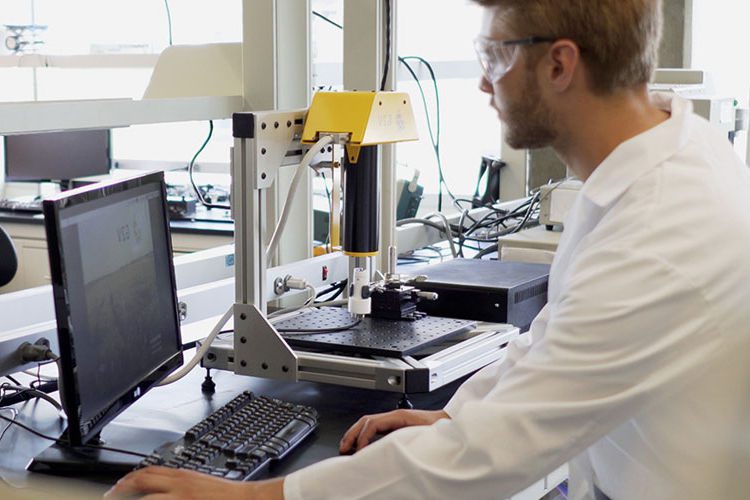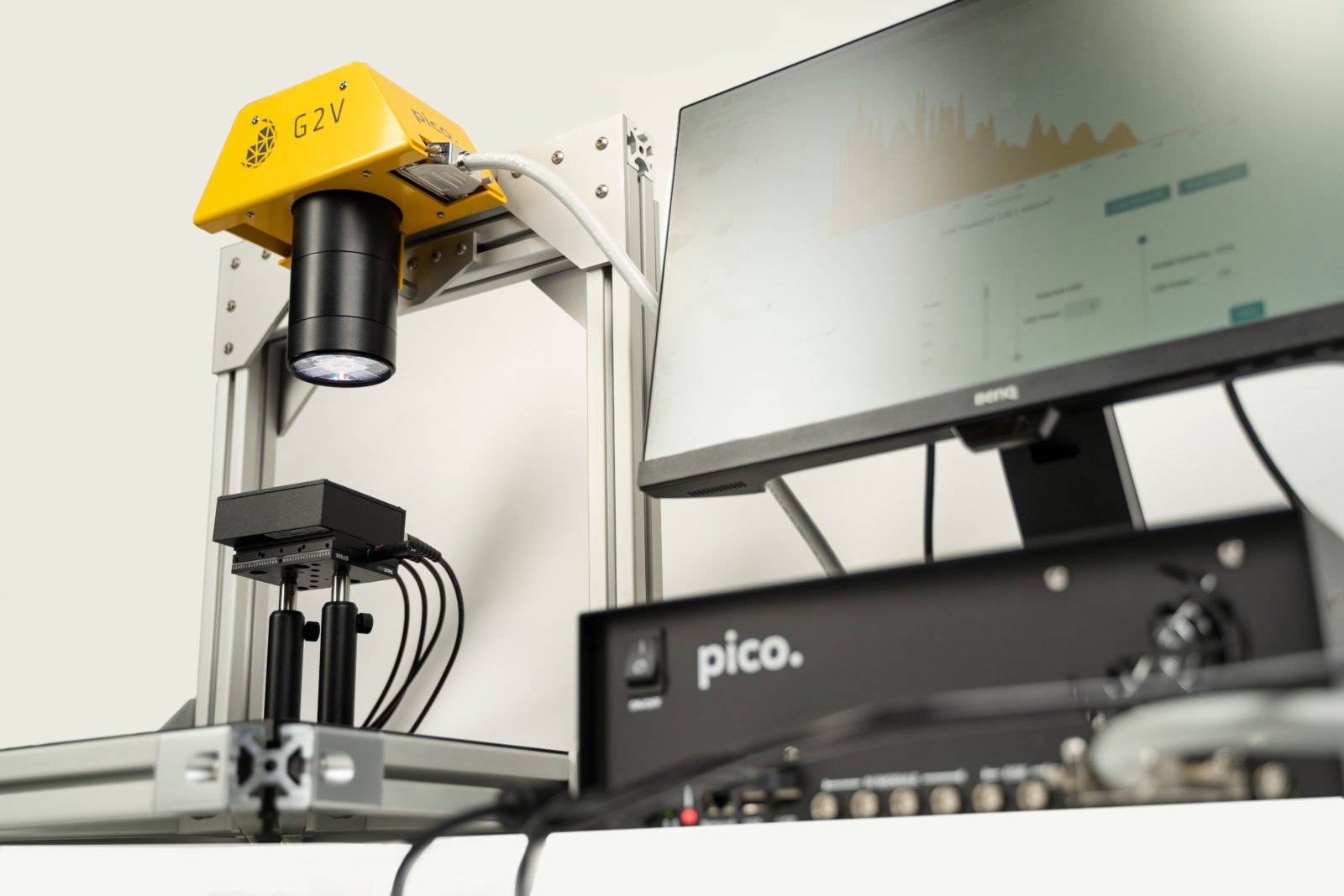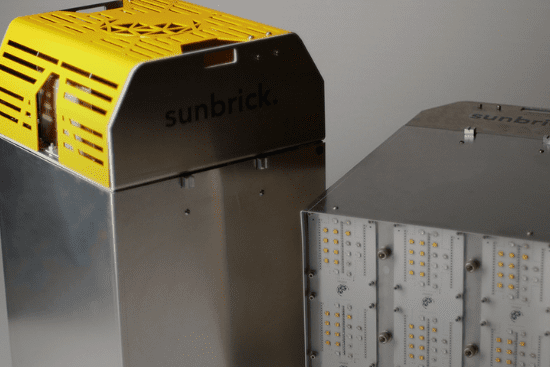








Engineered sunlight in the comfort of your lab any time, every time
Your research could range from photovoltaics to photochemistry or any of the innovative areas in between. To accelerate your research, you need the most precise and reliable instruments to probe the natural phenomena you are exploring. Otherwise, you spend valuable time ensuring your light source isn’t impeding your results.
What makes or breaks your discoveries is whether they are reproducible, valid, and accurate. Why risk compromising all your efforts by constantly needing to calibrate your instrument, monitor your samples for overheating, or replace bulbs every 1000 hours?
AAA LED solar simulator ensures these traditional problems are a thing of the past. Along with these core benefits, a genuinely high-end AAA solar simulator gives you the control, automation, and capability to give you confidence in your findings. At G2V, we created our solar simulator to remove these common problems, as we were once researchers, too.
Featured Innovations
The Engineered Sunlight™ For Your Cutting Edge Research
You’re on the cusp of something great. That excitement shouldn’t be minimized by worrying about how accurate your lighting is.

Pico™ AAA LED Solar Simulator for Academia
There are few things worse than being excited to finally get a new instrument just to realize you need to rearrange your entire lab. So you back burner your enthusiasm to plan, measure, and rearrange your space to accommodate. The Pico™ solar simulator provides a small footprint which is easily accommodated in any lab setting without sacrificing exceptional solar simulation.
Get back into what’s important to you and your research without missing a beat.
- Up to 32 tunable LED channels to provide research flexibility
- 10,000 bulb hours or a 2 year warranty
- Small form factor to integrate into glove boxes, fume hoods or restricted lab spaces
- IV and EQE modules to aid in automated quantification of solar cells
- Python API and network connectivity for automating and synchronizing with other equipment
Make light a lab condition you can completely control.

Sunbrick™ AAA LED Solar Simulator for Academia
Your samples are big, you're vetting physical phenomena that require large uniform light, and you require the instrument to be flexible and accurate with your changing research needs. The Sunbrick™ solar simulator has a tileable design that can scale without sacrificing AAA quality, all with exceptional tunability to meet your present and future research requirements.
An instrument so flexible other departments are going to be asking you to share it.
- Class A uniform area of 20 cm by 20 cm and a tileable design for larger area needs
- Up to 36 tunable LED channels to provide research flexibility
- 10,000 bulb hours or 2 year warranty
- Consistent light due to no bulb replacement or field calibration required
- Python API and LabView DLL for automation, scripting, and integration with other equipment
Large scale flexibility without sacrificing quality.

Scientific discoveries is your job, our job is to supply you with solar simulator knowledge.
Checking endless vendor websites for answers on technical specifications, prices, and reliability just leaves you with more questions. You shouldn’t need to spend hours searching just to get an answer, so we did it for you.
We have compiled a comprehensive guide on the Total Cost of Ownership between solar simulators.
Our guide will walk you through the basic considerations in terms of cost-to-benefit ratio, and performance metrics for choosing between different simulators in the market, explain the factors in a purchase decision like initial cost and upkeep expenses, and discuss why choosing the right simulator is key to enabling scientific discovery.
Maximize your research time and save your budget.
Case Study
Researchers working at multiple testing sites wanted to evaluate the performance of light-absorbing coatings in order to optimize the relationship between film thickness and materials cost. They needed to run their tests in controlled lab conditions that would allow them to quickly characterize their films but also needed to measure the response of their materials to outdoor day-night sunlight variations. Additionally, they needed to compare their results between their different testing sites to ensure adequate quality control.
Innovation: The Pico small-area solar simulator by G2V Optics can reproduce natural sunlight with high accuracy and its One-Click-Sun (beta) feature can simulate solar irradiance at different locations on earth any time of the year.
Outcome: The researchers installed the Pico into their assembly and characterization line to serve as a lab-sized sun capable of providing the radiation necessary to optimize their film deposition process. One-Click-Sun enabled the collection of data to make predictions on how their coatings would behave at different latitudes. Thanks to the Pico’s class AAA performance, film manufacturing reproducibility was verified at the different testing sites.
G2V's FAQs
One of the key advantages of LED solar simulators is their very small warm up times. It takes LEDs less than a few microseconds to start emission light after they have been turned on. In the practice, you can expect class A steady-state output from the simulator around 5 minutes after it has been turned on.
The G2V simulators have been designed to meet class A+ temporal stability requirements. Unlike your existing Xenon solar simulator or optical light source, you should not see any meaningful variation in output even when testing a sample continuously over the course of several days. Take solace in knowing your experiment’s repeatability isn’t tied to your lights maintenance.
A solar simulator is not the same as a light source. A solar simulator does contain a light source but it’s so much more than that! Solar simulators are specialized instruments that also contain a collection of optical pieces and electronic components carefully calibrated to match the sun’s spectral composition and energy flux with high accuracy.
LEDs, even white ones, only emit narrow band radiation. Therefore, many LEDs with emission in multiple wavelengths are necessary to achieve an output true to natural sunlight. Additionally, LED output must be individually and globally adjusted for irradiance of 1000 W/m² which is the accepted standard for terrestrial earth. Solar simulators also should meet industry standards such as IEC60904-9 which outlines spatial uniformity, temporal stability, spectral match, spectral coverage, and spectral deviation benchmarks.
The takeaway is that solar simulators are a worthwhile investment due to the specialized components and considerable work that goes into calibrating them to produce engineered sunlight. Need a more in-depth comparison, check out our pricing guide for more details.
The Sunbrick and the directed Pico models produce light with an angular full-width at half-maximum (FWHM) of approximately 20 to 30 degrees. Does your research require unique angles? Reach out to one of our Experts on a solution.
As with any solar simulator, an increase in substrate temperature is expected as a function of light exposure time. A benefit of LED simulators is that they do not emit excess IR radiation so unwanted heating is reduced but still produced. The question of will the small amount of excess heat affect your findings? If you are unsure, connect with one of our experts to shed some light on a solution.
Yes! Both of our solar simulator products have software integration options available so that you can program the scheduling and testing routines best suited for your unique research.
Our simulators have been designed to accurately reproduce the light output of the sun. Please avoid staring directly at the LEDs as UV light could damage your eyes. It is recommended to wear protective glasses when working with high reflectance surfaces.
Knowledge Base
Our Expertise. Your Home Base.
Scouring the internet for knowledge for applications related to solar simulation is never a fun task. In order to save the scientific community time we have been building a knowledge base from aerospace to materials testing on how solar simulators are utilized in the field. Visit the knowledge base to learn more about Perovskites, Aerospace materials testing, Extraterrestrial applications and much more.
IEC 60904-9:2020 Standard for Solar Simulators
In our modern era, nearly every industry has standards that set baselines for ensuring its associated products are safe and suitable to perform intended tasks. Solar simulation – reproducing sunlight – is no different, having standards that specify the requirements for solar simulators, and...
Solar Simulation
Consult with An Expert
Today’s research. Tomorrow’s future. No matter what you are working, you deserve the information you need, right when you need it. That’s why we have built a team of experts to consult with to assist in accelerating your discoveries.
We love to talk about science and are always eager to hear about your research. So let’s talk about your needs.
We’re curious about what you’re working on.
